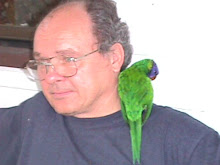I
t
was always going to be rather doubtful that May would produce anything
outstanding, or indeed come up with any real species diversity or abundance in
numbers of any given species. May is
late autumn in the southern hemisphere and we have already experienced some
rather chilly evenings. It does not
auger well for the rapidly approaching austral winter. And birds tend to be scarcer during the
colder spells.
Not
that May 2013 was numerical retarded on previous Mays. The 49 species was admittedly well below the
63 of May 2003 [the current record] but only one behind the 50 species of May 2004. It was one better than the 48 of 2010 and two
ahead of the 47 species in May 2009. It
clearly overshadowed the 30 species of May 2006 [still the lowest May on record
for Allen Road].
There were, as always, the regular faces, or should that
read, ”the regular feathers”? They were
there each and every day: the Laughing Kookaburra Dacelo novaeguineae and Torresian Crow Corvus orru; the Australian Magpie Cracticus tibicen and Magpie-lark Grallina cyanoleuca; the Galah Eolophus
roseicapillus and Grey Butcherbird Cracticus
torquatus; the Rainbow Lorikeet Trichoglossus
haematodus; the Apostlebird Struthidea
cinerea and Noisy Miner Manorina
melanocephala; the Crested Pigeon Ocyphaps
lophotes and Bar-shouldered Dove Geopelia
humeralis; etc.
They
were accompanied by the less frequent but nevertheless reasonably
well-presented regulars: the Australian Wood Duck Chenonetta jubata; the Masked Lapwing Vanellus miles; the Sulphur-crested Cockatoo Cacatua galerita and Australian King-Parrot Alisterus scapularis; the Blue-faced Entomyzon cyanotis and Striped Honeyeaters Plectorhyncha lanceolata; the Striated Pardalote Pardalotus striatus; etc.
On
the other hand, a number of species managed to put in only the one appearance
throughout the entire month. The Australian
Owlet-nightjar Aegotheles cristatus
[never known to outstay its welcome] called on20 May; the Bush Stone-curlew Burhinus grallarius early in the month,
on 2 May; the Scaly-breasted Lorikeet Trichoglossus
chlorolepidotus on 5 May; the Fan-tailed Cuckoo Cacomantis flablliformis, while in evidence all around us in the
broader South Burnett, visited us only on the 24th of the month; the
Pied Butcherbird Cracticus nigrogularis,
always in the shadow of its smaller cousin, the Grey Butcherbird, called only
on the last day, 31st May.
Then
there was the Black Kite Milvus migrans
on 5 May. It was the first new addition
to the Backyard List in a long time. We’d
walked to the “top” end of Allen Road [to its junction with the
Nanango-Maidenwell Road. I spotted the “crow”
flying across; Fay corrected the call to Black Kite on seeing the distinctive
forked tail. Oddly enough, two Whistling
Kites, perhaps a breeding pair, were in the same airspace at the same time and
to all intents and purposes it appeared as if the Black Kite was “associating”
with the Whistling Kites.
Photograph from www.birdway.com.au
The sudden appearance of the Black Kites in and around Nanango is a tale for another place at another time.
|
|
.jpg)

